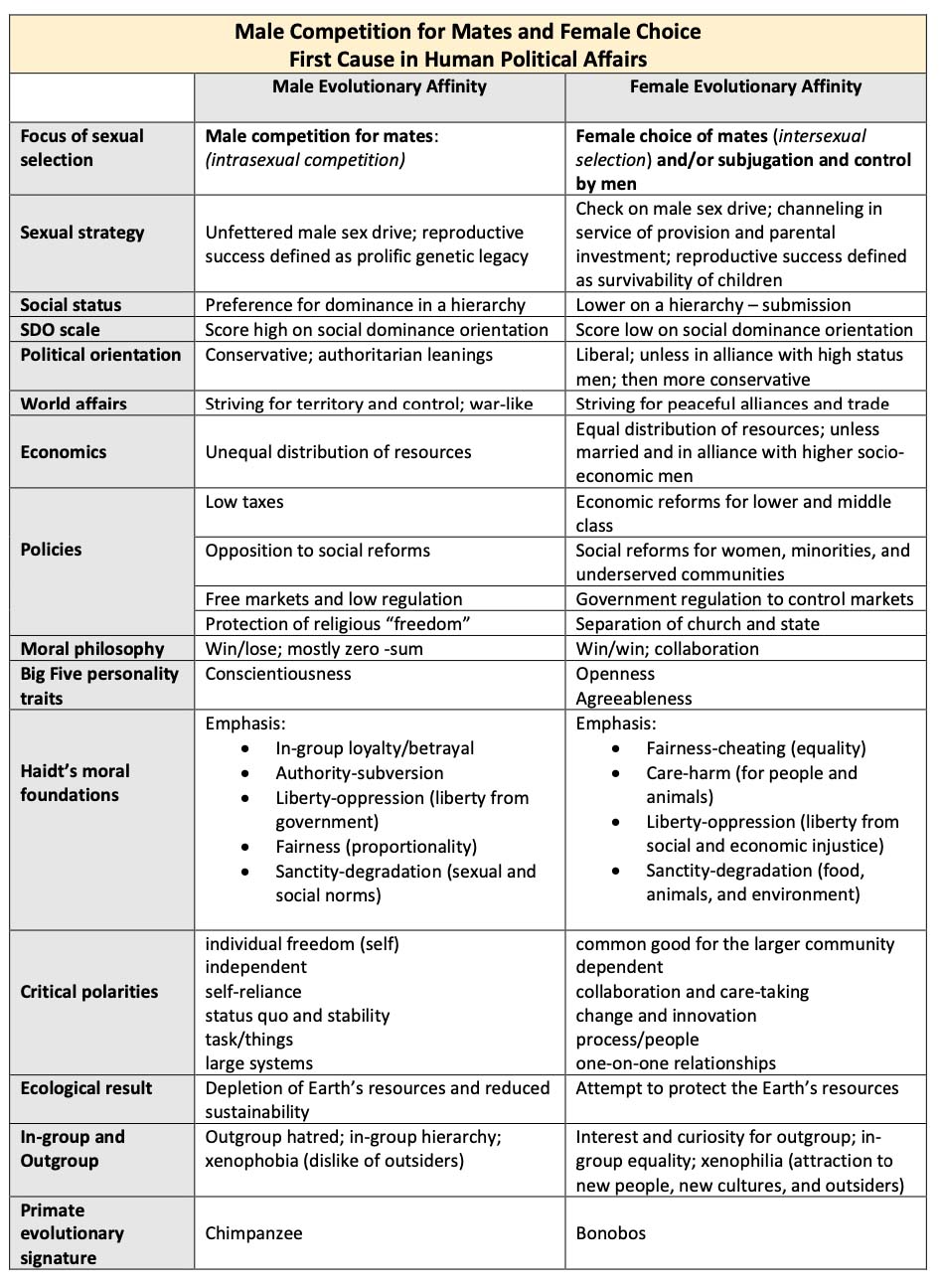I have striven not to laugh at human actions, not to weep at them, not to hate them, but to understand them ~ Baruch Spinoza, Tractatus Politicus, 1676
Below is a summary/review of key ideas from Parts 1 and 2 of this series that come (mostly) from research compiled by Hector Garcia in Sex, Power and Partisanship, How Evolutionary Science Makes Sense of Our Political Divide (2019). As with the chart on male-female evolutionary affinity in the Appendix, I am highlighting aggregate, research-driven observations that do not describe a particular individual or attempt to explicate the continuum of human behavior.
The Meaning of Righteousness
This post also introduces the tenets of Jonathan Haidt’s moral foundations theory in preparation for a deep dive in my next post. Drawing from Haidt’s brilliant book (The Righteous Mind), I will outline the moral foundations of liberals, conservatives, and libertarians. Stay tuned for that in Straight Talk Tuesday on December 8.
Review of Key Ideas from Parts 1 and 2
Let’s revisit some important ideas from Evolutionary Science and Our Political Divide: The Root of It – Part 1 and Root of Our Political Divide – Part 2: Post-Trump Authoritarianism.
Male-centric and Female-centric Strategies
- Conservatism is a male-centric strategy shaped by the struggle for dominance in mate competitions, while liberalism is a female-centric strategy derived from the protracted demands of rearing human offspring.
Daddy vs. Mommy
- Liberals (essentially Democrats) represent the “mommy” party (coined by Chris Mathews) with a focus on our health and welfare, including Social Security and Medicare.
- Conservatives (essentially Republicans) represent the “daddy” party with a focus on economic security and national defense. Conservative moral values arise from what George Lakoff (Moral Politics), calls the “strict father family” model.
Freedom Has At least Two Meanings
- Conservatives promote individual freedom (within constraints of group norms) and self-reliance, primarily defined as freedom from government.
- Liberals promote fairness, equality and freedom from injustices. The root of liberalism is the effort to rein in dominant males to prevent them from monopolizing resources that impinge upon the evolutionary fitness of those with less power.
Personality Matters
- Liberalism is characterized (on the Big Five Personality Scale) by an openness to experience (xenophilia).
- Conservatives show more conscientiousness (preference for order and control) and a preference for more “closed” cognitive systems as measured on the Big Five Personality Scale. Conservatives score more highly than liberals on measures of following rules, traditionalism, and dedication to the existing way of doing things.
In-group vs. Out-group is Damn Near the Entire Ball Game
- Conservatives have a strong preference for in-group members and show more ethnocentrism and xenophobia (fear of outsiders) than liberals. Xenophobia helped our ancestors avoid diseases from outsiders. Because ancestral men could not leave their group for fear of death, xenophobia towards outsiders and dominance over other groups was evolutionarily sensible. (See Haidt insight #5 below.)
Conservatives are More Disgusted by Pathogens and Sexual “Stuff”
- Conservatives have more “disgust” sensitivity than do liberals. They show more fear of pathogens and disapproval of “nonnormative” sexual behaviors.
Women and Liberals Are More Empathic
- Women and liberals show more empathy than men and conservatives. Less empathy among men had evolutionary “fitness” benefits.
- Women and liberals are more concerned with fairness and turn-taking than conservatives.
Conservatives Have a Dominance and Masculine Orientation
- Conservatives are more comfortable with social hierarchies and score higher on the Social Dominance Orientation scale than do liberals.
- Conservatism is correlated with masculinity, physical stature, and spatial abilities used to survive a harsh ancestral environment.
Conservatives are Triggered More by Threat
- Conservatives (especially men) may exhibit authoritarian personality traits when triggered by “threats” from outsiders and the experience of economic displacement.
Six Moral Foundations
In the next (and last) post in this series, I will explain the moral foundations theory of Jonathan Haidt. Haidt uncovers the sources of belief that “create” liberals and conservatives and reveal why folks identify with, and vote for, Democrats or Republicans. Haidt has named six moral foundations central to the human experience: care/harm, fairness/cheating, loyalty/betrayal, authority/subversion, sanctity/degradation, and liberty/oppression. Haidt claims that liberals primarily use three foundations – care/harm, fairness/cheating, and liberty/oppression, whereas conservatives utilize all six. Haidt’s moral foundations are signified on the “first cause” chart in the Appendix becuause they adhere to male versus female evolutionary polarity.
Instinctual Legitimacy of Both Sides
Haidt tells us that moral psychology is not just about how we treat one another, it is also about binding groups together, supporting essential institutions and living in a sanctified and noble way. Moral foundations theory provides very important insights about the instinctual legitimacy on each side of the political divide.
How to Engage is Not Based on Reason
In my next post (December 8), I will also share thoughts about how we might engage each other in a way that allows more understanding, compassion, and acceptance. As you will witness, neither the content nor the process of unification is based on reason or facts. For now, as preparation for details about the moral foundations, let’s reflect on ten insights from Haidt’s research (adapted from Creative Conflict Wisdom’s Blog, 2012). Keep these in mind for holiday conversations; I will give more practical tips on December 8.
Ten Insights from Jonathan Haidt
“Your mother and I are separating because I want what’s best for the country and your mother doesn’t.” ~ Cartoon caption from The Righteous Mind, p 318
1. Intuitions come first, strategic reasoning second.
The “Elephant” (our automatic self-righteous pattern recognition) directs the “Rider” (our rational conscious brain) much of the time, and in conflict, makes us invent (retroactively) rationalizations for our positions, without much account of our real interests, let alone the interests of the other side.
2. There’s more to morality than harm and fairness.
Much of the world adds loyalty, authority, sanctity, and liberty to their moral sensibilities (moral foundations). The spectrum of moral foundations is broader in non-Western societies (and among conservatives).
3. Pluralism is not relativism.
There is a plurality of ideals, but they are finite. “Everything doesn’t go,” but we can understand other ideals even when we don’t share them.
4. Morality binds and blinds.
We are products of multi-level selection and in tension between our selfish and groupish tendencies. Religion helps create ever larger moral communities. Our moral frameworks create group cohesion but also blind spots about how the frameworks operate inside us.
5. We have a “hive switch.”
We have a capacity to transcend self-interest, like bees acting in unison for the hive. But, we are predominantly structured for hierarchy with in-group versus out-group psychological mechanisms. (The “entire ball game” above.)
6. We are not as divided in politics as moral dualists (Manichaeans) would have you believe.
Some people are “good” and some are not, but our minds are designed for groupish righteousness that makes those distinctions suspect.
7. We are deeply intuitive creatures.
Our gut feelings drive our strategic reasoning.
8. It is hard to connect with those who live in different moral matrices.
But it is not impossible to connect with another person if you acknowledge and understand their moral foundations.
9. Look for commonality.
Before wading into morally-based arguments, establish some trust, show some interest, and listen for what you have in common.
10. Some things are sacred to others as some things are sacred to you.
Don’t try to “bargain” as if the sacred is not part of the equation. Jerusalem is not for sale by Jews, Israelis, Muslims, or Christians, but that doesn’t mean we can’t find some way out of that conflict. Consider the conflicts about wearing a mask and following Donald Trump – even that evokes the sacred. (With a nod to #3 above — not “everything goes.”) As Haidt says, “We are all stuck here for a while, so let’s try to work it out.”
Appendix
Nature provides a first draft, which experience then revises; built-in does not mean unmalleable; it means organized in advance of experience. ~ Gary Marcus, neuroscientist
The chart below is a meta-theoretical understanding of male and female evolutionary tendencies and captures many insights from Parts 1 and 2 of this blog series.

4 Comments
Submit a Comment
Please Note: Your comment may take up to 12 seconds to register and the confirmation message will appear above the “Submit a Comment” text.

I love the opening image, as always! It captures the tension between differing ends of a spectrum: the structure and power of commandments and the openness and wonder of nature. The key points that follow highlight the range of responses that are captured in the chart at the end. Can chimpanzees and bonobos learn to live together in relative harmony some day? I’m looking forward to diving into Haidt’s analysis in the next post. Perhaps we will find a role for dolphins, too?
Neither chimpanzees nor bonobos like to swim, but apparently, there was some in-breeding of these two primate species among chimps living close to the Congo River (a very important barrier separating them in evolutionary development.) Chimps and bonobos live together inside of us. Bonobos are “in vogue” right now – (their sexual activity is indeed more casual) but we are (very over-simplistically) more chimpanzee than bonobo in nature.
Presumably, individual males and females express these traits along a spectrum, which means that some males express “female evolutionary affinity” on some topics and some females express “male evolutionary affinity” on some topics. The table is very helpful in identifying the specific traits. Seeing what the psycho-social landscape looks like might even make it possible for one to consciously override some basic tendencies and become a more rounded human or perhaps one more tilted in the direction of the greatest good for the greatest number. Thanks for the clear delineations.
Yes, Pat. You understand. There is a continuum but evolutionary adaptation tilts the emphasis to the degree that sex differences matter and influence more than we commonly acknowledge. Importantly, you underscore the possibility of more conscious behavioral control by increasing awareness. Thank you so much, Pat, for your time and attention. Your thoughts always elevate the conversation.